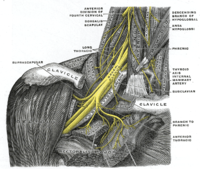
Photo from wikipedia
Symptomatic scapular winging resulting in scapular dyskinesia leads to a wide spectrum of clinical complaints, most notably periscapular pain. The malpositioning of the scapula, termed through use of the acronym… Click to show full abstract
Symptomatic scapular winging resulting in scapular dyskinesia leads to a wide spectrum of clinical complaints, most notably periscapular pain. The malpositioning of the scapula, termed through use of the acronym SICK (scapular malposition, inferior-medial border prominence, coracoid pain and malposition, and dyskinesia of scapular movement), is due to the irregular activity of one or more of the periscapular muscles. In particular, the serratus anterior, innervated by the long thoracic nerve, is a key muscle that stabilizes the scapula and provides coordinated scapulohumeral rhythm. If the long thoracic nerve is injured, this results in significant shoulder dysfunction and scapular winging that may require surgical intervention. The purpose of this Technical Note is to present our preferred technique to treat symptomatic scapular winging due to long thoracic nerve palsy through transfer of the pectoralis major with its bone insertion to the inferior edge of the scapula.
Journal Title: Arthroscopy Techniques
Year Published: 2017
Link to full text (if available)
Share on Social Media: Sign Up to like & get
recommendations!